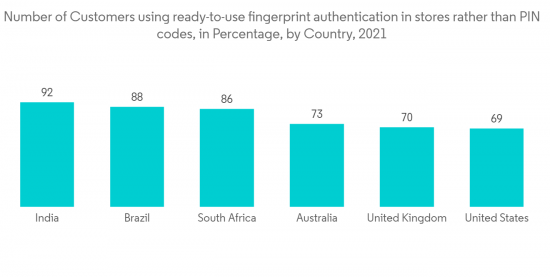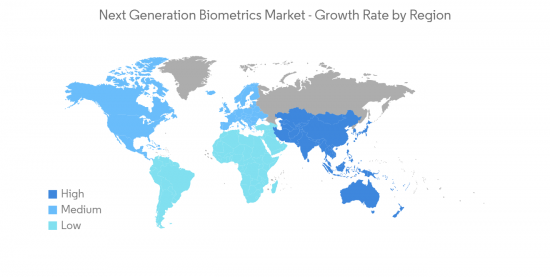 |
市場調查報告書
商品編碼
1326282
下一代生物識別市場規模和份額分析 - 增長趨勢和預測(2023-2028)Next Generation Biometrics Market Size & Share Analysis - Growth Trends & Forecasts (2023 - 2028) |
||||||
※ 本網頁內容可能與最新版本有所差異。詳細情況請與我們聯繫。
下一代生物識別市場規模預計將從 2023 年的 429.6 億美元增長到 2028 年的 942.3 億美元,預測期內(2023-2028 年)複合年增長率為 17.01%。
下一代生物識別市場的主要趨勢之一是商業話語的範式轉變,轉向更多的隱私和更少的安全威脅。最終用戶越來越需要集成解決方案,而不是依賴傳統方法。
主要亮點
- 由於恐怖活動增加以及敏感數據和信息盜竊行為增加,國家安全問題日益嚴重,預計下一代生物識別市場將出現強勁增長。例如,2022年8月,智利將引入自動生物識別系統(ABIS)來打擊有組織犯罪。通過比較民警 (PDI)、民事登記處和國際刑警組織的生物識別記錄,該系統可立即識別已識別的罪犯、非法移民和身份不明的死者。
- 全球範圍內不斷增加的身份欺詐正在限制全球市場的增長。據Onfido稱,身份欺詐同比增加了43%,犯罪分子採用更複雜的技術,使用逼真的2D/3D面具和顯示攻擊(例如在屏幕上顯示一個人的照片)來欺騙身份身份驗證系統,導致複雜的欺詐行為增加了57%。由於十分之九的消費者能夠輕鬆訪問數字服務,欺詐者的機會就更大了。
- 下一代生物識別行業正受益於電子卡和生物識別護照的興起。例如,哥斯達黎加計劃於 2021 年 9 月和 2022 年推出生物識別護照。這種新護照是使用尖端安全技術創建的,以拒絕欺詐企圖。它還符合國際民用航空組織製定的要求。在預測期內,這些進步可能會創造市場發展增長機會。
- COVID-19 的爆發顯著增加了對非接觸式生物識別解決方案的需求,尤其是在醫療保健領域,並對各行業造成了重大干擾和調整。先進的多因素和多模式生物識別解決方案因其準確性和對 COVID-19 社交距離規範的適用性而變得越來越重要。
- 企業必須避免使用指紋、掌紋和手鑰匙掃描儀,以盡量減少身體接觸和病毒傳播。這些行為為面部識別設備和用戶友好的虹膜掃描奠定了基礎。這種流行病引發了非接觸式生物識別技術的趨勢,這些技術評估面部、步態和語音識別以進行準確的身份驗證,這對市場增長是積極的,預計在預測期內將增長。
下一代生物識別市場趨勢
銀行和金融業增長最快的部門
- 各國央行正在推進生物識別認證的引入。Bank of America, JPMorgan Chase, Wells Fargo允許客戶使用指紋登錄手機銀行。此外,銀行呼叫中心還引入了語音識別技術來識別客戶。下一代生物識別認證可以消除對密碼的需求,從而提高客戶滿意度,從而增加銀行業對生物識別技術的需求。
- 根據 Visa 2022 年 5 月進行的一項民意調查,86% 的用戶熱衷於在付款時使用生物識別技術來驗證自己的身份。70% 使用生物識別技術的受訪者表示它更簡單,46% 的受訪者表示它比憑證或 PIN 碼更安全。因此,由於銀行欺詐的增加,網上銀行和移動支付中生物識別安全的採用預計將有助於市場增長。
- IDEMIA 表示,2021 年 7 月,作為全球生物識別解決方案先驅的印度銀行業現在更加熱衷於在後新冠時代部署安全實用的生物識別技術。IDEMIA致力於提供各種尖端的生物識別保護和交易解決方案。BFSI 領域這些新興市場的發展預計將在未來幾年推動下一代生物識別市場。
- 由於BFSI領域越來越多地使用數字技術,互聯網金融和數字化運營近年來越來越受歡迎。許多銀行現在使用生物面部識別技術通過 ATM 機訪問賬戶,無需刷卡。例如,2022 年 5 月,MasterCard為實體店推出了一種生物識別支付方式,該方式依賴於面部識別生物識別技術,而不是智能手機、智能卡或記憶的 PIN 碼。

預計亞太地區在預測期內將出現顯著增長
- 該地區的市場預計新興經濟體將強勁增長,預計在預測期內將穩定增長。除了消費電子產品和政府部門外,隨著下一代生物識別技術的應用,該地區的醫療保健行業預計也會增長。
- 由於該地區技術創新的進步以及生物識別設備的可負擔性和廣泛使用,預計該地區將實現增長。此外,下一代生物識別行業正在崛起,政府和多個商業部門利用這項創新來識別個人。
- 遊戲零售、銀行和金融行業以及醫院等終端用戶對生物識別技術的需求正在不斷增加。這種需求對全國市場的擴張產生了重大影響。例如,2021 年 6 月,China Construction Bank (CCB) 與 IDEX Biometrics 合作,選擇在其數字人民幣計劃中採用生物識別憑證。該銀行此前為其數字人民幣錢包提供了一款應用程序。得益於支持 NFC 的生物識別智能卡,用戶無需智能手機即可使用加密貨幣。
- 亞太國家市場的擴張是由新興經濟體擴張、旅行興趣增加以及物聯網設備使用增加等因素推動的。例如,2021 年 11 月,“Mantra Softech”和北方邦政府簽訂了一項使用生物識別技術分配口糧的協議。此外,2021 年 12 月,作為“DIGI YATRA SCHEME”的一部分,印度政府引入了“面部識別技術”(FRT)用於旅行者登記。最近發生的這些事件預計將加速生物識別行業在該領域的擴張。
- 2022年9月,作為亞太地區持續增長的一部分,下一代身份驗證平台Incode透露,它已與TOTM Technologies作為經銷商合作,為印度尼西亞市場提供其身份解決方案Incode Omni。 。TOTM Technologies 致力於將 Incode 世界一流的安全且以客戶為中心的生物識別解決方案引入印度尼西亞,從而擴大該地區的業務範圍。因此,亞太地區的這些市場發展預計將在預測期內推動下一代生物識別市場。

下一代生物識別行業概述
下一代生物識別市場高度分散,眾多市場參與者正在根據市場需求投資技術創新。此外,由於未來的預期需求,下一代生物識別市場競爭非常激烈。該市場的主要參與者包括IDEMIA, Fujitsu Limited, NEC Corporation, Thales Group, Siemens AG。
- 2022 年 9 月:全球領先的數字身份驗證和身份驗證供應商 Onfido 推出 Motion,這是一種領先的生物識別活性解決方案,可改進真實身份平台。Motion 已通過 iBeta 2 級認證,可提供流暢、安全且全面的消費者身份驗證。
- 2022 年 8 月:IDEX Biometrics ASA 和 Realtime AS 開始戰略合作,創建並商業化世界上第一張具有冷存儲和數字財富錢包以及數字身份的 Web3 生物識別交易卡。符合EMV標準的一體化生物識別支付卡預計將於2023年上半年上市。
其他福利:
- Excel 格式的市場預測 (ME) 表
- 3 個月的分析師支持
目錄
第 1 章 簡介
- 研究假設和市場定義
- 調查範圍
第二章研究方法論
第三章執行摘要
第四章市場動態
- 市場概況
- 市場驅動力
- 增長傾向電子護照項目
- 生物識別技術與智能手機的集成推動增長
- 市場製約因素
- 對侵犯隱私的擔憂是增長的挑戰
- 系統的高初始成本限制了增長
- 行業吸引力——波特五力分析
- 供應商的議價能力
- 買方議價能力
- 新進入者的威脅
- 替代品的威脅
- 競爭對手之間的競爭
- 技術快照
第五章市場細分
- 按解決方案類型
- 人臉識別
- 指紋認證
- 虹膜識別
- 掌紋認證
- 簽名識別
- 其他解決方案類型
- 最終用戶行業
- 政府
- 防禦
- 旅行和出入境管制
- 家庭安全
- 銀行和金融服務
- 衛生保健
- 其他最終用戶行業
- 按地區
- 北美
- 歐洲
- 亞太地區
- 中東/非洲
- 拉丁美洲
第六章 競爭格局
- 公司簡介
- IDEMIA
- NEC Corporation
- Fujitsu Ltd
- Siemens AG
- Thales Group
- Cross Match Technologies
- Fingerprint Cards AB
- Suprema Inc.
- RCG Holdings Limited
- Safran SA
第七章投資分析
第八章市場機會與未來趨勢
The Next Generation Biometrics Market size is expected to grow from USD 42.96 billion in 2023 to USD 94.23 billion by 2028, at a CAGR of 17.01% during the forecast period (2023-2028).
One of the key trends witnessed in the next-generation biometrics market is a paradigm shift in business discourse toward more privacy and fewer security threats. The end-users are increasingly looking for integrated solutions rather than depending on conventional methods.
Key Highlights
- The next-generation biometric market is anticipated to grow at a significant growth rate due to the rising number of terrorist activities, coupled with the increasing theft activities on the part of crucial data and information that have raised concerns regarding national security. For instance, in August 2022, Chile is implementing an automatic biometric identification system (ABIS) to combat organized crime. By comparing the biometric records of the civil police (PDI), the civil registry, and Interpol, the system would instantaneously identify recognized criminals, illegal migrants, and the deceased who lack any identity.
- The rising identity fraud across the globe is restricting market growth globally. According to Onfido, Identity fraud rose 43% YoY, with sophisticated fraud increasing 57% as criminals employed smarter tactics, utilizing realistic 2D/3D masks and deploying display attacks (for instance, showing a picture of a person on a screen) to try to spoof verification systems. And with 9 out of 10 consumers comfortable accessing digital services, the opportunities for fraudsters are further increasing.
- The next-generation biometric industry benefits from the increase in electronic cards and biometric passports. Costa Rica, for example, in September 2021, is slated to launch its biometric passport in 2022. The new passport was created using the most advanced security technology to reject fraudulent attempts. It also complies with the demands the International Civil Aviation Organization sets forth. Throughout the projected term, these advances may generate growth opportunities for market development.
- The COVID-19 outbreak significantly increased demand for touchless biometrics solutions, particularly in the healthcare sector, and created substantial disturbances and adjustments in various industries. Advanced multifactor and multimodal biometrics solutions are becoming increasingly important due to their accuracy and conformance with COVID-19's social separation norms.
- Companies must refrain from using fingerprint, palm print, and hand-key scanners to minimize physical touch and virus transmission. These actions are laying the groundwork for facial identification equipment and user-friendly iris scanning, which will be applied in several contexts. The outbreak brought about a trend toward contactless biometric technologies that assess face, gait, and speech recognition for accurate identification, which benefitted the market growth and is expected to grow over the forecast period.
Next Generation Biometrics Market Trends
Banking and Financial Industry to be the Fastest Growing Sector
- Central Banks are rolling out biometric authentication. Bank of America, JP Morgan Chase, and Wells Fargo allow customers to log in to mobile banking via fingerprint authentication. Voice authentication is also deployed in bank call centres to identify customers. Next-generation biometric authentication can improve customer satisfaction by eliminating the need for passwords and increasing the demand for biometrics in the banking sector.
- A Visa poll from May 2022 found that 86% of users are eager to utilize biometrics to verify their identification while making payments. 70% of respondents who used biometrics said it was simpler to use them, and 46% said they were safer than credentials or PINs. Thus, increasing the adoption of biometric security for internet banking and mobile payments is expected to contribute to the market growth due to increasing banking fraud.
- According to IDEMIA, in July 2021, a pioneer in biometric solutions worldwide, the Indian banking industry is now more eager to implement safe and practical biometric technologies in the post-Covid era. IDEMIA is seeking to provide various cutting-edge biometric protection and transaction solutions. These developments in the BFSI sector are expected to propel next generation biometrics market over the coming years.
- Internet finance and digital operations have become increasingly popular over the past few years due to the increased use of digital technology in the BFSI sector. Many banks now use biometric facial recognition to access accounts through ATMs, eliminating the requirement to punch a card. For instance, in May 2022, Mastercard introduced a biometric payment method for physical establishments that relies on face recognition biometrics instead than smartphones, smart cards, or memorized PINs.

Asia-Pacific to Witness a Significant Growth Rate over the Forecast Period
- The market in the region is expected to witness significant growth in emerging economies, estimated to grow steadily over the forecast period. Apart from the consumer electronics and government sectors, the healthcare sector is expected to experience growth in the application of next-generation biometrics in this region.
- The region is expected to grow with innovation advancement and the region's widespread use of biometric devices at an affordable price. Additionally, the next-generation biometrics industry is increasing as the government and several business sectors use this innovation to identify individuals.
- The need for biometric identification technologies is rising among end-users, such as gaming retail, the banking and financial industry, hospitals, etc. This demand is having a substantial impact on the market's expansion nationwide. For instance, in June 2021, in conjunction with IDEX Biometrics, the China Construction Bank (CCB) chose to employ biometric credentials in its digital renminbi initiatives. The institution previously made available an app for digital yuan wallets. Users will not require a smartphone to utilize virtual currency owing to the NFC-enabled biometrics smart card.
- The rise of the market in the Asia Pacific countries is fuelled by factors including the economic development of developing nations, rising interest in travel, and increased use of IoT devices. For instance, in November 2021, "Mantra Softech" and the administration of Uttar Pradesh reached an agreement to distribute rations using biometrics. Furthermore, in December 2021. the Indian government implemented "Facial Recognition Technology" (FRT) for traveler registration as part of the "DIGI YATRA SCHEME." These recent events are anticipated to accelerate the expansion of the biometric industry in this area.
- In September 2022, as a continuation of its Asia Pacific growth, Incode, the next-generation identity confirmation platform, revealed that it partnered with TOTM Technologies as a distributor to provide identification solutions, Incode Omni, to the Indonesian market. By introducing world-class, safe, and customer-focused biometric solutions from Incode to the area, TOTM Technologies is dedicated to widening the scope of Indonesian businesses. Thus, these developments in the Asia-Pacific region are expected to propel the next-generation biometric market over the forecast period.

Next Generation Biometrics Industry Overview
The next-generation biometrics market is highly fragmented due to numerous market players investing in technological innovation aligned with the market need. Moreover, the next-generation biometric market is highly competitive due to the expected demand in the future. Some of the key players in the market are Idemia, Fujitsu Ltd., NEC Corporation, Thales Group, and Siemens AG.
- September 2022: Onfido, the top worldwide digital identity validation, and authentication supplier launched Motion, a cutting-edge liveness solution for biometrics that will improve its Real Identity Platform. Motion is iBeta Level 2 approved and offers smooth, secure, and inclusive consumer verification.
- August 2022: IDEX Biometrics ASA and Realtime AS launched strategic cooperation to create and commercialize the world's inaugural Web3 biometric transaction card with cold storing and digital property wallets, as well as digital identity. In the first half of 2023, the marketplace is predicted to get these all-in-one biometrics payment card that complies with EMV standards.
Additional Benefits:
- The market estimate (ME) sheet in Excel format
- 3 months of analyst support
TABLE OF CONTENTS
1 INTRODUCTION
- 1.1 Study Assumptions and Market Definitions
- 1.2 Scope of the Study
2 RESEARCH METHODOLOGY
3 EXECUTIVE SUMMARY
4 MARKET DYNAMICS
- 4.1 Market Overview
- 4.2 Market Drivers
- 4.2.1 Inclination of Growth toward E-Passport Program
- 4.2.2 Integration of Biometrics in Smartphones Driving Growth
- 4.3 Market Restraints
- 4.3.1 Fear of Privacy Invasion Challenging Growth
- 4.3.2 High Initial Cost of Systems Restricting Growth
- 4.4 Industry Attractiveness - Porter's Five Forces Analysis
- 4.4.1 Bargaining Power of Suppliers
- 4.4.2 Bargaining Power of Buyers
- 4.4.3 Threat of New Entrants
- 4.4.4 Threat of Substitute Products
- 4.4.5 Intensity of Competitive Rivalry
- 4.5 Technology Snapshot
5 MARKET SEGMENTATION
- 5.1 By Type of Solution
- 5.1.1 Face Recognition
- 5.1.2 Fingerprint Recognition
- 5.1.3 Iris Recognition
- 5.1.4 Palm Print Recognition
- 5.1.5 Signature Recognition
- 5.1.6 Other Types of Solutions
- 5.2 By End-user Vertical
- 5.2.1 Government
- 5.2.2 Defense
- 5.2.3 Travel and Immigration
- 5.2.4 Home Security
- 5.2.5 Banking and Financial Service
- 5.2.6 Healthcare
- 5.2.7 Other End-user Verticals
- 5.3 Geography
- 5.3.1 North America
- 5.3.2 Europe
- 5.3.3 Asia-Pacific
- 5.3.4 Middle East & Africa
- 5.3.5 Latin America
6 COMPETITIVE LANDSCAPE
- 6.1 Company Profiles
- 6.1.1 IDEMIA
- 6.1.2 NEC Corporation
- 6.1.3 Fujitsu Ltd
- 6.1.4 Siemens AG
- 6.1.5 Thales Group
- 6.1.6 Cross Match Technologies
- 6.1.7 Fingerprint Cards AB
- 6.1.8 Suprema Inc.
- 6.1.9 RCG Holdings Limited
- 6.1.10 Safran SA













